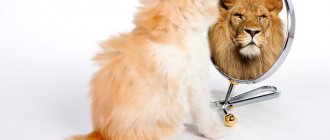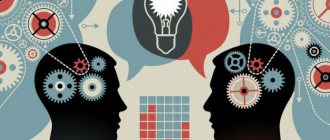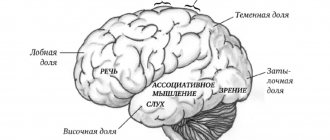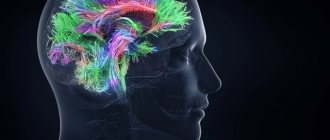January 19, 2021
Hello, dear readers of the KtoNaNovenkogo.ru blog. We all perceive the world through sensations (we look, hear, feel, comprehend), but each individual person has a preferred channel of perception.
In psychology, people are divided according to the type of their perception into four main groups: visual (sight prevails), auditory (sounds are important), kinesthetic (appreciate tactile sensations) and digital (mind prevails).
Moreover, the main method of perception also affects the character of this person. Therefore, understanding who is in front of you, you will be able to establish contact with him much easier.
Today I want to talk in detail about kinesthetics, since such people stand out from the crowd and are “atypical.”
Signs of perception
Perception is a cognitive process in psychology, the result of which is the formation of a subjective picture of the world through the direct impact of an object or phenomenon on the human senses.
The completed image of an object in the human mind is formed as a result of the combined work of various analyzers. Thus, through vision one can draw a conclusion about the color of an object, and through tactile palpation one can obtain information about its texture. If you take an object in your hands, you can feel its weight, with the help of smell you can feel its smell, and through the receptors on the tongue you can determine the taste. It turns out that in the process of getting to know a subject, cognition and perception merge together.
Important! Perception is always subjective. Individual characteristics of the work of analyzers and a person’s life experience explain the fact that the finished image of an object perceived by different people may differ. The process of perception is inextricably linked with thinking, attention, memory, speech, and the emotional-volitional sphere.
Digitals
Digital people master the world around them with the help of logical judgments. They are not characterized by stooping and thinness. They gesture little and try not to express their emotions. In general, these people are characterized by balance.
Digitals are rational, closed-minded and can even be arrogant.
To win over such an interlocutor, it is necessary to maintain distance during the conversation, show respect and refuse to lie. Regarding the last point, digitals easily recognize deception and try to exclude communication with people who tend to resort to cunning.
People of this psychotype know how to clearly plan and organize their lives. While still at school, they begin to make plans for the future and later strictly follow them. Thanks to their determination, they achieve great heights in life. Digital people can make a good career or build their own business.
They develop well in such areas as management, economics, politics, medicine and psychology.
It is worth noting that digitals can try their hand at criticism. They know how to express their thoughts well and use logical reasoning to easily explain their point of view.
Currently, there are 4 main psychotypes. The most common of these is kinesthetic. Every adult needs to be able to distinguish between psychotypes and understand their characteristics. This knowledge will help you more easily establish contact with people around you and avoid conflict situations.
Article design: Oksana Grivina
Levels of perception
The process of forming a holistic image of an object goes through 4 levels:
- One of the analyzers notices the object. A person can see it, smell it or hear some characteristic sound.
- Correlating the signal from the analyzer with a particular object. This process occurs with reference to the existing in memory ideas about the objects of the surrounding reality and the correlation of the detected feature of the object with one or another standard.
- Identification and identification. As a result of mental activity, a person comes to the conclusion about what kind of object it is, what it is called, and what it is needed for. The result of the process is the formation of a complete image of the object.
Forming an image of an object
Types of information presentation
Everyday life and human activities are associated with numerous flows of information. Information can be presented in the following forms:
- The textual method of presenting information is a set of special characters written on paper or electronic media. Such symbols are numbers and letters of the alphabet.
- The graphical method of presenting information is often used to display statistical data or when there is a need to use visualization for a better understanding of the text. For this purpose, charts, histograms, drawings, charts, and tables are used.
- Telephony and radio broadcasting use radio waves and sound signals to present information.
- On television, light signals are used to present information.
- Multimedia. This type of information presentation involves the use of a computer and combines text, audio, graphic information and video.
First of all, you need to understand why a person, in principle, needs to know which type he belongs to? How can this information help him in life? In total, there are 4 main types of perception:
- visual – using vision;
- auditory – due to the hearing organs;
- kinesthetic – the senses are involved here;
- digital – thinking is used.
It cannot be that the other systems are not turned on at all, but one of them certainly prevails. It then begins to launch the thinking process, represents the initial impetus that provokes other mental processes: memory, visualization, imagination.
For example, you are advised to imagine soft cat fur:
- A person with a visual type of perception first of all imagines the animal itself, and only then remembers how pleasant its fur is to the touch.
- Auditory - will reproduce the sounds that the animal makes, and only then turn to other sensations.
- The kinaesthetic will instantly feel the soft fur touching his skin, after which the image of a cat will appear in his head.
- The digital must mentally say the name of the object (cat), internal speech will help him recreate its image and fur in his imagination.
It turns out that we can all imagine a four-legged pet, but for some the image will immediately pop up in their heads, while for others it will be reproduced later using their prevailing system. It is through the trigger system that the stimulus is transformed into an image in the brain. Accordingly, if you want to learn to better understand your loved ones, as well as yourself, and understand in what form the information presented will be absorbed faster and better, you will need knowledge about the types of perception.
Let's take a closer look at all the types with their characteristic features.
Audials
Auditory is the rarest psychotype. This includes people for whom hearing is the best way to remember information. They are easy to identify during a conversation. They are very chatty. Able to start a conversation with a stranger and support third-party topics. During a conversation, they, like kinesthetic learners, can avoid eye-to-eye contact.
It should be noted that people of this psychotype are demanding of all sounds. For example, the humming of the refrigerator or the creaking of the floor will irritate them more than others. It is quite easy to win the affection of the audio audience. To do this, you need to make your speech more expressive and pleasant. In this case, be sure to use different intonations.
Auditory learners react very strongly to screaming. They perceive speaking in a raised voice as an insult. It is important to note that people of this psychotype rarely pay attention to the external type of the interlocutor; for them, a pleasant conversation is most important.
Little auditory learners tend to eavesdrop on adult conversations. They usually draw ugly and have clumsy handwriting. There is no point in scolding the baby for this. It is better to use his natural data and direct his development in the right direction. For example, buy a musical instrument.
Types of perception in people
All analyzers always participate in the process of accepting the surrounding reality, but only 1 of them is the leading channel for obtaining information. So, when reading, the leading channel is vision, when listening to music – hearing, etc. Perception is usually classified on various grounds.
In social science, a peculiarity of people's perception of each other has been identified. When meeting someone, it is not possible to obtain enough information to form a complete, complete image. Only in the process of long-term communication do people get to know each other so much that a psychological portrait of a friend is formed in their minds.
At the time of the first meeting, people try to make a good impression if they are interested in a communication partner. They seem to stand on their tiptoes, wanting to become morally superior. At the very beginning of a relationship, people diligently disguise their shortcomings and weaknesses. A person’s primary image of an interlocutor is formed based on an analysis of his posture, posture, gestures, and communication style.
People's perceptions of each other
In addition, if the interlocutor reveals his profession, the person mentally attributes to him the stereotypical qualities of a typical representative of a particular field of professional activity. Thus, people tend to believe that teachers lead a correct lifestyle, and musicians are vulnerable, impressionable, and romantic.
A person’s social status also has a significant impact on the opinion others have about him.
Interesting fact. If a person has a beautiful appearance, then communication partners tend to endow him with positive personal qualities that he actually does not possess. If outwardly the interlocutor reminds a person of one of his relatives, sympathy for him arises from the first minutes of communication.
I once observed a married couple at my psychological appointment. She is a well-groomed, slender, hair-to-hair blonde, with a taut back. Having aligned her legs in high heels evenly to each other, this beauty - a woman with her head held high - gracefully sat on the edge of the chair. “A very uncomfortable, but impressive-looking pose,” I thought.
Is compatibility needed5
There is a misconception that when searching for a soul mate, you need to take into account as many similarities in character and habits as possible. However, many people know the phrase “opposites attract.” This is what makes two people incredibly attractive to each other, and also gives a feeling of familiar warmth nearby. You shouldn’t chase similarities; it’s much better to choose “your” person with your heart.
The same applies to the sexual type. In real life, it is not always possible to find an auditory or kinesthetic learner like yourself. But this does not mean that your relationship is doomed to failure. On the contrary, such an experience will become a challenge for you, which will help you find common ground, negotiate and meet halfway. This is a real relationship, and not one that begins only after strict analysis, devoid of feelings.
Regarding the description of types, everything is also quite conditional. In life, you may meet visual people who will also be happy to have conversations and enjoy your moans at night. There are no identical people, there is only the wrong approach to them. The best thing you can do in this situation is to learn to talk to your partner. Do not accumulate resentment and misunderstandings. Always be on the same page and don’t be shy to show it.
Is compatibility necessary? It is impossible to answer this question unambiguously. Even if you are from different planets, you can still make sure that both of you have a good relationship. All that is needed for this is simply to take into account each other's wishes. Turn down the lights if your chosen one is kinesthetic, or learn to voice your actions if you are in bed with an auditory person.
Learn to dress up and look brand new when going to a meeting with a visual artist. It is much easier to create a whole drama on the topic of incompatibility than to try to do something. Make up your mind and don’t be afraid to experiment, because the sweetest moments in life happen when people decide to undertake desperate follies and exploits.
How are types of perception determined?
Diagnostics of the type of perception
Knowing your type of perception helps a person learn more effectively. There are special techniques that can be used to determine the dominant type of perception.
To begin with, a person can observe his mental activity. Where does the presentation begin: with a picture (visual) or with a feeling (kinesthetic), with sounds (auditory) or with logical meanings (digital)? In addition, the dominant type of perception reveals itself in speech: people tend to more often use those words that have a connection with their dominant perceptual system.
You can also determine the type of perception by the dominant short-term memory. A visual person is a person who finds it easier to remember graphic information. An auditory learner is a person who remembers better by hearing. If for effective memorization a person needs to rely on bodily sensations, then he is a kinesthetic learner. Digitalists are those who focus on logic when memorizing.
In addition, S. Efremtseva developed a method for determining the dominant perceptual modality.
A little theory i
A person has 5 types of senses at his disposal. Vision, hearing, touch, taste and smell. It is believed that “their” person has an incomparable aroma that subconsciously attracts the opposite sex. Many ladies claim that the smell of their boyfriends' sweat excites them more than an aphrodisiac. This is all logical and understandable, because in this way you can determine without words how suitable your partner is for you and whether a close relationship is possible between you.
But what directly concerns sex is concentrated in only three of the five senses: touch, vision and hearing. As you might guess, there are also only three types with different types of perception. The first are kinesthetics. They perceive everything through touch. The second are visual. For them, the whole world is a huge palette of sounds and voices. And the third are visual. Visual learners need to be surrounded by beautiful things. Some also distinguish a type of discrete people - people based on logic, but this is more of a personality type, so we will not consider them.
Basic properties of perception with examples
The mental process under consideration has the following properties:
- Integrity is a characteristic of the final image that arises as a result of a combination of sensations. The final image is always complete. For example, a fly is perceived by a frog as an object of hunting only when the fly moves. If the fly is motionless, the frog does not try to catch it, since it does not perceive it as an insect.
- Constancy - once acquired characteristics of a particular object, a person tends to correlate it with this particular object for a long time, accurately forming the final image. Minor changes in the characteristics of an item do not lead to difficulties with its classification. So, for example, a young man dates a tall girl who has blue eyes and blond hair. One day his girlfriend dyed her hair brunette. But he still perceives her as his partner; she has not become a stranger to him.
- Subjectness - the ability to combine an object with a generic group according to key characteristics. For example, green, round, sweet - this is an apple. Green, long, with paws and a tail - this is a crocodile. The process of classifying items into generic groups may take some time. Sometimes, for a correct correlation, a person needs to come up and take a closer look at the object or pick it up.
Objectivity of perception
- Structurality is reflected in the complexity of the perception process, which cannot be reduced simply to the sum of sensations from different senses. Replacing one of the key characteristics leads to the formation of a completely new image. So, for example, something large, iron and capable of floating is a ship. However, a large, iron one, capable of moving along railroad tracks is a train, not a ship.
- Selectivity – selection of 1 object from the background. The scope of perception is limited. A child cannot play with many toys at the same time. First of all, he will take the brightest or largest toy. This turns on selectivity: the baby chooses the most eye-catching object by color or size. Having chosen his favorite toy from a variety, the child loses interest in the others for a while; only the best one is in his field of perception.
- Apperception is the dependence of image formation on the individual characteristics of a person’s analytical systems and his life experience. The same object can be perceived differently by different people. So, for example, the Bible for believers is one of the main books of life, which sets out the rules of life and the foundations of society, but for an atheist it seems to be just a book that is no different from any other work of art.
- Perception activity is a person’s ability to be aware of the surrounding reality and accumulate experience in using objects. For example, initially the baby does not know what function the spoon performs. He can knock on the wall with it, look at it like in a mirror, dig sand with it. One day his mother shows him that he can eat with a spoon. Having learned this, the baby understands that a spoon is a cutlery, and not a hammer, a mirror or a spatula.
Errors in Perception
As in any other mental process, errors occur in perception, as a result of which a person forms erroneous ideas about objects and phenomena. Typical perceptual errors include illusions and hallucinations.
Illusion
Illusion is a distorted perception of objects or phenomena. There are 2 types of illusions:
- Affectogenic illusions caused by emotions and feelings. For example, a timid person can clearly see a monster in the shadow of a bush, while a person with low self-esteem seems to be disliked by his superiors and is constantly being picked on.
- Pareidolic illusions, which are characterized by the appearance of fantastic images when interacting with reality. For example, black spots on a white sheet can be mistaken by a person for insects.
Characteristic
Who is a kinesthetic learner? This is the individual who receives the most information through touch. The skin is the largest human organ by area and has the most receptors . Heat, pain, cold, tenderness, pressure - we feel all this through the skin. However, due to genetic or external factors, these receptors are developed differently in each person. It is because of this that everyone has their own pain threshold, their own perception of temperature. Even a small child, despite the fact that all children have fast metabolic processes, and due to this they feel the decrease in temperature worse, has its own individual gradation. A person with this psychotype relies most on his feelings. Every event, good or bad, is associated with the fact that he feels the moment of touch.
How does the type of perception influence the learning process?
Knowing the characteristics of your own perceptual system helps organize the learning process.
The process of presenting information for visual learners must be accompanied by clarity. They have good skills in working with text and, if desired, quickly master the technique of speed reading. They remember information well by making mind maps or graphs, working with demonstration models, and gaining knowledge through experimental activities.
Important! Extraneous sounds will not interfere with the concentration of the visual. With the TV on, he will be able to prepare for the exam just as well, using charts and tables, as in silence.
The main channel of perception of educational material for an auditory child is hearing. Lectures are comfortable for him. He learns new material well by participating in discussions and conversations.
For kinesthetic learners, the learning process should involve the possibility of movement and practical actions. The most suitable forms of organizing the educational process for him are practical and laboratory work.
Important! These people have unstable attention. However, their advantage is the rapid switching from one activity to another.
Digital students excel in logical disciplines and programming. Computerized learning suits them. The material will be absorbed by the digital if he understands its logical basis, and new information will be superimposed on his existing knowledge and organically fit into his picture of the world.
Kinesthetic learners at work
It is better for kinesthetic learners to choose professions related to their peculiarities of perception of the world around them. The following areas of activity are suitable for such people:
- Massage. Dependence on touch will allow you to realize your full potential. A kinesthetic person will be able to find pain points and work every muscle of the body;
- Dancing. Kinesthetic people are people of action, so a profession related to constant movement will satisfy the necessary needs. In addition, in dancing there is always tactile contact, touching your own body, your partner;
- Tasting. Those who love to savor food and drinks will shine in this area. A developed sense of smell will help you navigate the world of aromas;
- Cosmetology. The sensations transmitted through the fingers will help to create miracles of transformation for any person.
Any profession related to tactile perception is suitable for such people. For example, this could be working with fabric, embroidery.
Kinesthetic learners are punctual and efficient. Everyone takes great care with themselves, taking many measurements. That's why they become engineers and builders. They do an excellent job of making and installing furniture. They often devote themselves to science, paying attention to experimental activities, and work with people. For example, they work in the field of medicine, become nurses, doctors.
Doctor at reception
Kinesthetic and other psychotypes cannot exist in their pure form. But one way of interacting with reality always prevails. A kinesthetic person is a person who experiences the world through smell and touch. He cannot live without tactile sensations. Therefore, comfort and convenience come to the fore in life for him. If a person tries to touch his interlocutor once again, then you should not be offended by him - this is his type of knowledge and acquaintance.
Types of perception in communication
In situations of interpersonal communication, types of perception reveal differences, which can be seen in people's behavior.
Thus, visual learners pay great attention to a person’s appearance, facial expressions and gestures when communicating. Eye contact is important for them. Sometimes it seems that such people are able to guess the thoughts of their interlocutor.
Perception in communication
The visual person himself feels comfortable during the communication process and takes an open pose. These are great storytellers.
Attention! They tend to establish a spatial distance with the interlocutor: being too close to a communication partner, visual learners experience discomfort.
It’s nice to communicate with an audio audience. Their speech is literate, rich in intonations, and its pace is comfortable for perception. They understand their communication partners perfectly. A raised tone and insults towards the auditory person will lead to him refusing to communicate.
For kinesthetic learners, the key to a good conversation is the setting. They truly enjoy discussing personal experiences and emotions, both their own and those of others.
Something to remember! Kinaesthetic will not let someone you don’t know close to you. When communicating with loved ones, kinesthetics need physical touch.
Digital people rarely openly show emotions when communicating with others. They quickly grasp the meaning of what the interlocutor said. They don’t like prefaces; they want to quickly get to the point and facts.
Character traits
Definition of kinesthetic:
- When speaking, avoids eye contact, in most cases concentrates on a specific object and usually looks down.
- Prefers to act instantly, gets irritated by slowness.
- When communicating, he describes the external characteristics of an object: black, cold, heavy, and so on...
- When dining, he enjoys every type of food.
- When conducting a dialogue, he can disconnect from the tendency to immerse himself in his experiences.
Kinesthetics have certain external features:
- They stick to wearing worn-out clothes and familiar shoes, giving preference to comfort and familiarity. Comfort is prioritized over other issues.
- Fussiness in movements, constant desire to touch everything, feel the tactility of sensations.
- Lots of facial wrinkles in the nose area. Aggression and hostility are mainly expressed in the form of a change in facial expression with a demonstration of disgust.
By nature, this type of person is calm and balanced. Due to their lack of desire to be the center of attention, they do not stand out from the rest. Their comfort zone is their own environment. They have a tendency towards a melancholic mood, but they quickly get rid of it.
Kinesthetic child: how to raise
The foundations of perception as a mental process are laid in infancy. However, at an early age, the baby’s perception is still very imperfect. In the first years of life, a child develops visual-tactile and visual-motor connections that arise in the process of manipulative activities with objects. Later, the manipulation turns to “feeling” a new object with the gaze - this indicates a new stage in the development of perception.
In preschool and primary school age, perception is determined by the impressionability and emotionality of children: involuntary perception prevails over voluntary perception.
The most difficult for children to master are the spatial properties of objects that are associated with visual, kinesthetic and tactile sensations. During preschool childhood, children successfully master concepts such as shape, size and size of objects, learn to determine the distance and spatial arrangement of objects relative to each other.
The perception of time poses serious difficulties for children of primary preschool age. They do not always correctly use the words “tomorrow”, “yesterday”, “later”, “earlier”.
Children's perception of time
As the child masters the surrounding world, as well as systematic schooling, the child’s conditioned reflex connections improve, which is an impetus for the development of perception.
The key role in the development of children's perception belongs to adults. Thus, parents and teachers teach children how to operate with objects, guide the child’s development process, and draw his attention to the essential characteristics of objects and phenomena of reality. An adult’s detailed and complete answers to a child’s questions about certain objects and phenomena will mean a lot.
Attention! To develop a child’s perception, it is necessary to organize his play and practical activities with objects. During the game, children learn to distinguish the basic properties of objects: color, weight, shape, size. In order for a child to study an object and understand its purpose, he needs to touch it and try to perform various actions with it. During the game and practical activities, optimal conditions are created for the interaction of analyzers, which leads to the formation of a holistic view of the world.
Children's artistic activities have enormous potential for the development of perceptual skills. In drawing from a model and in the process of sculpting, children learn to feel proportions, convey the shape and size of an object, and distinguish between shades of a palette. Thus, by older preschool age, the child’s perception becomes controlled and arbitrary.
During the period of schooling, perception is improved due to the variety of academic disciplines and various types of activities of children under the guidance of a teacher. To develop perceptual skills, the teacher must use visual aids: firstly, this stimulates the work of several analyzers at once, and secondly, it contributes to better memorization of information. Independent search work of students is of great importance.
Thus, perception plays an important role in human life. Perceptual skills formed at a high level ensure successful learning, harmonious personal development, and the ability for scientific creativity. It is important for adults to remember that this ability will not be formed by itself; it is necessary to create conditions for the child to play with different objects from an early age.
Brief perception of reality
The most important thing in raising children is to choose the right tools of influence that attract attention. For auditory learners it will be sounds, and visual learners will give up everything for the sake of beautiful pictures, but what to do with a kinesthetic child? He almost doesn’t listen because he doesn’t want to take in information by ear. He cannot be made to concentrate by giving an example or showing interesting illustrations.
Kinesthetic children often find themselves misunderstood by adults who simply could not or did not want to find an approach to them. Because of this, they may even be recklessly diagnosed with ADHD (attention deficit hyperactivity disorder).
Remember how cinema depicts the classic image of a scientist on the verge of a great discovery. He sat, thought, crumpled up dozens of pieces of paper with notes, got up, measured the room from corner to corner several times, grabbed his forehead and exclaimed “eureka”! This is a typical algorithm of actions for a kinesthetic learner.
A kinesthetic person is a person who...
Auditory, visual, kinesthetic - these groups of people are not precise and exclusive (much like temperament types, when it is impossible to find a pure sanguine, choleric, phlegmatic or melancholic). Each of us perceives the world with different analyzers. It’s just that one of the channels is more clearly expressed and prevails over the others.
Therefore, according to some characteristics, a person can be classified as kinesthetic to a greater extent than other groups. To understand this, you need to look at the behavior of this person:
- If such people take part in a conversation, they try to get as close as possible to the interlocutor and reduce the distance between each other. If possible and appropriate, touch the person. This does not mean that a person does not respect personal space or is in a hurry to be intimate. Simply in this way he will better perceive information during a conversation.
- During a conversation, such people can become lost in their thoughts, so it makes sense to gently touch them at such moments. To the shoulder, for example, and bring them back to reality.
- If something can be touched, a kinesthetic learner will definitely do it immediately. He will fiddle with his scarf, touch the leaves in the park, savor every spoonful of a new dish.
- Such people prefer to immediately start doing something rather than hang around in thought when making an important decision. They don’t understand why people around them are so slow and constantly weigh the pros and cons.
- Their place of residence may be in complete disorder, but at the same time, things are laid out in such a way that it is convenient to reach and take them at any time. This creates comfort and coziness for them.
- Kinesthetic people can wear the same favorite thing for many years just because it feels so good on their body.
- If such a person is upset about something, he is in a bad mood, and you want to console him, then the best thing is to hug him. This is how he will feel that you care and worry about him.
- During intimacy, he (she) turns off the light to focus on tactile sensations. They love to touch, kiss, stroke.
- Kinesthetic learners have a good sense of their own body. Therefore, they often choose dancing, massage, and sports as their professions.









